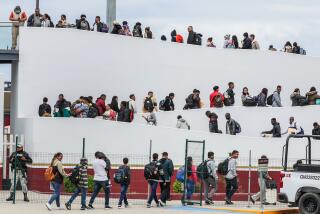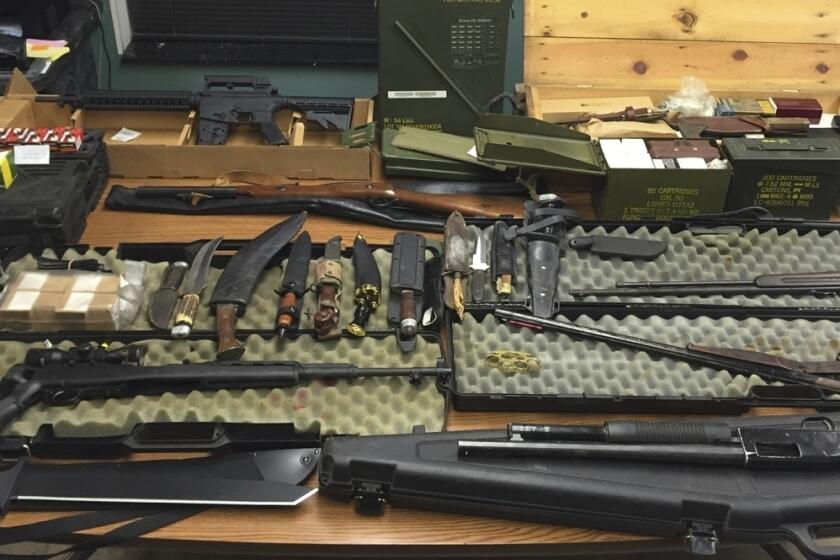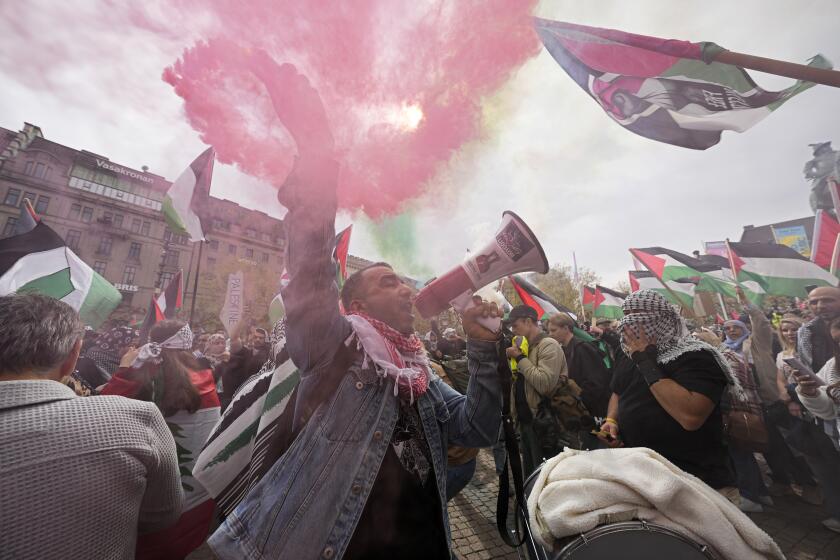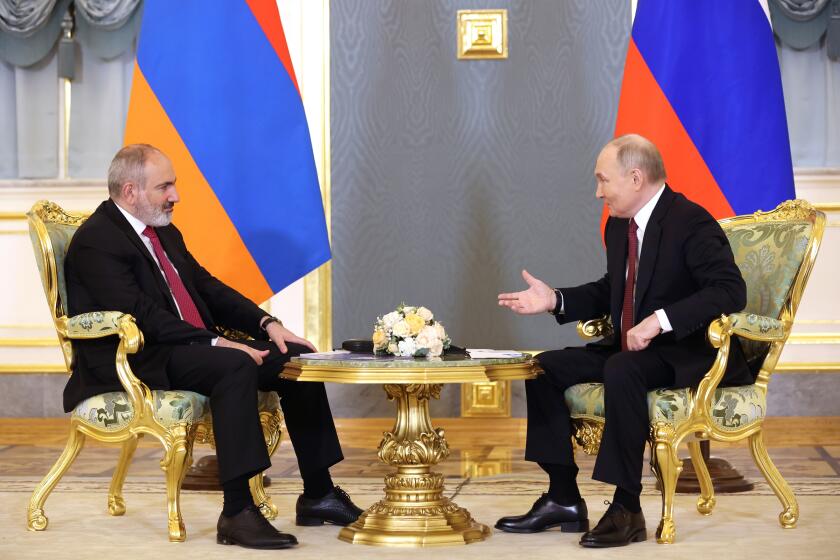U.S. Gleans Some Gems From Tape
U.S. intelligence officials and other terrorism experts say the chilling video of Osama bin Laden gloating about the Sept. 11 attacks provides both good news and bad about America’s ability to prevent another deadly terrorist strike.
Several officials said Bin Laden’s claims that most of the hijackers didn’t know one another or even know the game plan until the final hours indicates Al Qaeda enforces strict need-to-know operational security. That makes early detection extremely difficult.
“It shows that unless you get to the right people at the right time, it’s tough to get at these guys and prevent an attack,” a U.S. intelligence official said. “We could have captured some of the hijackers on Sept. 9, gotten them to tell us everything, and we still wouldn’t know what they were going to do.”
But analysts also say Bin Laden’s detailed foreknowledge of the plot--assuming he spoke truthfully during what appeared to be an off-the-cuff dinner nearly two months after the attack--suggests he and a few key aides maintained some degree of direct operational command.
That means their capture or death in the Afghan war could significantly undercut Al Qaeda’s ability to launch major new terrorist attacks in the near future.
“This was centrally dominated and controlled, which means the guidance, inspiration and resources won’t be there anymore once we get the top guys,” said another intelligence official.
He and other officials added, however, that Al Qaeda already had trained hundreds of terrorists, and that an unknown number of “sleepers” may already be in place or in the process of plotting future attacks even without Bin Laden at the helm.
“Even without a nerve center, they’re going to remain, regroup and carry out actions,” the intelligence official said. “They’ve still got to be rooted out cell by cell.”
The 40-minute portion of the tape that features Bin Laden apparently was recorded Nov. 9 in a guest house near Kandahar, the southern Afghan city then controlled by the Taliban. The CIA obtained the tape in late November from a Pushtun source who apparently recovered it near Jalalabad in eastern Afghanistan, one official said. Pushtuns are the dominant ethnic group in Afghanistan, but do not comprise a majority of the population.
A government analyst who has studied Bin Laden and his network for years was struck by his relaxed demeanor, noting that the video offers a rare unscripted view of the Saudi-born millionaire turned accused global terrorist leader.
Most known Bin Laden tapes are more formal, showing him delivering stern Islamic sermons, ranting at the United States and its allies, or firing weapons in rugged outdoor settings.
The grainy, homemade video--shot in a brightly painted room with plush cushions on the floor, travel posters on the wall and rifle-toting guards at the ready--shows him sitting on the floor and boasting and laughing about the casualties and destruction at the World Trade Center.
“It showed the way he really is with people in his political environment, the way he interacts with people in his peer group,” the analyst said. “It sort of struck me as a locker room kind of bragging: ‘Hey, do you believe I did this?’ ”
Many officials called the tape a “smoking gun” that proves Bin Laden’s clear responsibility. James Steinberg, former deputy national security advisor to President Clinton, said Bin Laden’s degree of direct command of the Sept. 11 attacks is no longer at issue.
‘Clearly, Completely and Fully in the Loop’
“Whether he was the actual planner of this, he was clearly, completely and fully in the loop,” Steinberg said.
But one former CIA officer with long experience running covert operations noted that Bin Laden didn’t say he had directed the attack, simply that he was told the details and warned five days before it occurred.
“Bin Laden’s been bottled up, watching his back, only sending stuff out through messenger to Pakistan,” he said. “Did he really control something as complicated as this? Or was he just dining out now on good stories?”
The former officer warned that U.S. intelligence has erred in the past. At one point last year, he said, an intercepted communication in Afghanistan indicated that “the engineer” was arriving that night. A terrorist bomber known as “the Engineer” recently had been targeted and killed in the Middle East.
“Everyone went to general quarters,” the official said. “They thought, ‘Great, the big bomber is coming.’ I had to tell them that in Afghanistan, if you’re not a mullah, you’re an engineer. Otherwise you can’t get a job. Every commander there is called an engineer. The whole thing fizzled out.”
Yonah Alexander, director of the terrorism center at the Potomac Institute, a nonprofit think tank in suburban Washington, said the tape “won’t go very far” to convince U.S. critics in the Muslim world. “They’ll say it’s an American conspiracy and plot, that we’re playing propaganda against them,” he said.
Daniel Benjamin, a former terrorism expert in the Clinton White House, said the tape also shows how Bin Laden believes that he is leading not a global terrorist movement that has killed thousands of people in scores of countries, but a return to the pre-modern, golden age of Islam.
“It casts the event in very direct terms as the moment for a great Muslim revival,” he said. “And it casts him as the bearer of the true faith and the true leader of that revival.”
U.S. officials said it is still unclear precisely who made the tape or why. The tape appeared to be shot over an earlier video made of Afghan men and children examining the remains of a U.S. Air Force helicopter that crashed in central Afghanistan due to bad weather. After the crew was rescued, U.S. F-14 jets destroyed the helicopter.
Whoever filmed the dinner with Bin Laden hit the start button on the video camera after filming the aircraft wreckage. Thus the Bin Laden meeting begins in the middle of the tape. When the tape ran out, the cameraman apparently rewound the tape to the beginning and started again, so the end of the meeting is at the start of the tape.
That, combined with the often inaudible soundtrack and the shaky camera, suggests an amateur or homemade video by one of Bin Laden’s aides.
“It doesn’t appear to be designed for recruitment, or to show the troops to bolster morale,” said an intelligence official. “If they had, they would have used a fresh tape and put a microphone on the guy.”
Bin Laden mostly spoke in a corner with a visitor identified only as a sheik. He appeared to be paralyzed from the waist down, according to intelligence officials, since his legs were covered throughout by a blanket and Bin Laden went over to kiss him in greeting.
The officials said the visitor apparently is from Saudi Arabia because of his accent and because of numerous references he made to Saudi clerics and mosques.
He spoke repeatedly, for example, of Sulayman ul Alwan, a fiery cleric from the Buraida region north of Riyadh. U.S. intelligence believes Alwan has recruited Saudi militants to join Bin Laden’s side in Afghanistan, and may have played a role in recruiting some of the Sept. 11 hijackers. Nearly all were from Saudi Arabia.
Bin Laden’s Inquiries Reveal Ties to Homeland
Bin Laden, in turn, also made frequent comments and queries about prominent Saudi clerics. The references may offer insight into Bin Laden’s murky relationship with his homeland.
The pampered son of a Saudi construction magnate, Bin Laden had direct support from Saudi intelligence services when he began recruiting Muslims to fight against Soviet forces in Afghanistan in the 1980s.
But Bin Laden turned his ire against the Saudi royal family after they invited U.S. forces to help dislodge Iraq from Kuwait in 1990-91. Bin Laden uses the continued presence of U.S. troops, which he calls a violation of Islam’s holiest ground, as core to his terrorist screed.
The Saudi government lifted Bin Laden’s citizenship in the mid-1990s, but he retains widespread support in many mosques. They have contributed both recruits and millions of dollars to Al Qaeda.
Justice Department and FBI officials said it wasn’t clear if the tape could be used in criminal prosecutions or even in the presentation of evidence to federal grand juries overseeing an ongoing terrorism investigation.
Those grand juries are being used to subpoena suspects and hand up indictments, as was the case Tuesday when Zacarias Moussaoui was indicted on six counts for his alleged role in the Sept. 11 plot.
But the tape may not help prosecutors seeking to make a case against Bin Laden or his co-conspirators.
“I’m not sure if it will provide anything to us other than that he had knowledge . . . and that some others didn’t have knowledge,” said one FBI official. “If it was not obtained with a legal search warrant, I don’t know if we can use it.”
*
Times staff writer Josh Meyer contributed to this report.
More to Read
Start your day right
Sign up for Essential California for news, features and recommendations from the L.A. Times and beyond in your inbox six days a week.
You may occasionally receive promotional content from the Los Angeles Times.







